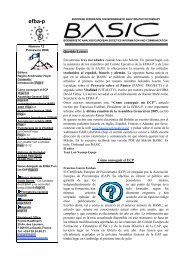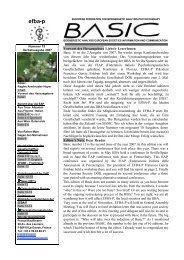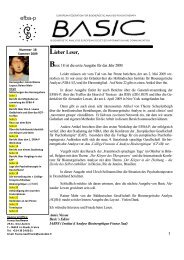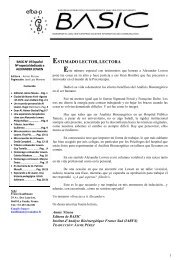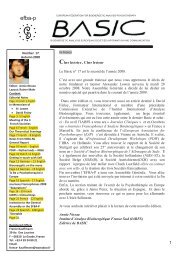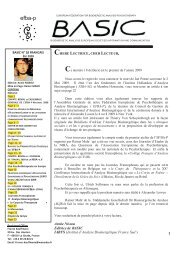December 2004 - European Federation for Bioenergetic Analysis ...
December 2004 - European Federation for Bioenergetic Analysis ...
December 2004 - European Federation for Bioenergetic Analysis ...
Create successful ePaper yourself
Turn your PDF publications into a flip-book with our unique Google optimized e-Paper software.
ody perception and liveliness, is often a necessary condition <strong>for</strong> clients to expose themselves<br />
to worrying emotional experiences.<br />
5. Please provide evidence that your approach includes processes of verbal exchange,<br />
alongside an awareness of non-verbal sources of in<strong>for</strong>mation and communication.<br />
<strong>Bioenergetic</strong> <strong>Analysis</strong> uses in its sessions all possibilities and channels to communicate<br />
with each other. Voice, gesture, mimicry, eye contact, body-expressions, position movement<br />
and touch are - besides language - <strong>for</strong>ms to communicate and to get to know the client<br />
(Lowen 1980, 1981, Klopstech 2002). Especially the non-verbal <strong>for</strong>ms of communication,<br />
including body-contact, are very suitable <strong>for</strong> the occupation with the client’s earliest<br />
childhood; since at that time they have been the only, or at least the main means of<br />
communication. Like language, body-contact is interconnected with the therapeutic<br />
intervention (Mahr 1994, Carle 2002). The hence appearing images, feelings and emotions<br />
can be explored and analysed. The therapeutic process and the therapeutic relationship<br />
determine what kind of body-contact is useful.<br />
Body-contact and body-oriented interventions in <strong>Bioenergetic</strong> <strong>Analysis</strong> are also used to<br />
improve the person’s self - perception, to relax those muscles and tissue and to deepen the<br />
breathing. Since there tensions serve the resistance of intense and unwanted feelings, their<br />
release leads again to the contact to the underlying rage, injuries, desires and so on, and make<br />
it accessible <strong>for</strong> analysis. The cathartic acting out of feelings the <strong>Bioenergetic</strong> <strong>Analysis</strong> is<br />
often connected with, above all aims at making the frozen or repressed feelings again<br />
perceptible and to reanimate them. Usually they alone do not lead to healing. They are<br />
imbedded in the therapeutic process and have to be seen and analysed in their biographic,<br />
social and psychological context (Steinmann 2002).<br />
Psychotherapeutic work with body-contact is only possible, when it is exclusively used<br />
<strong>for</strong> the therapeutic process. Only by being absolutely safe as to this, the client can allow<br />
touch, can learn to understand its meaning and the correlated fears that come up with it. There<br />
is no therapeutic reason <strong>for</strong> any sexual contact, because a therapeutic relationship<br />
fundamentally differs from real relations with their own aims and rules in our life. Then, the<br />
<strong>Bioenergetic</strong> <strong>Analysis</strong> does not allow personal relations and connections between therapist<br />
and client, neither be<strong>for</strong>e, nor during or after therapy (Mahr 1994).<br />
Even since Freud, but more specifically since Wilhelm Reich the concept of energy has<br />
been playing an important role in body-psychotherapy. By describing energetic structures and<br />
processes the <strong>Bioenergetic</strong> <strong>Analysis</strong>, as an occidental <strong>for</strong>m of therapy, leans on the<br />
13



